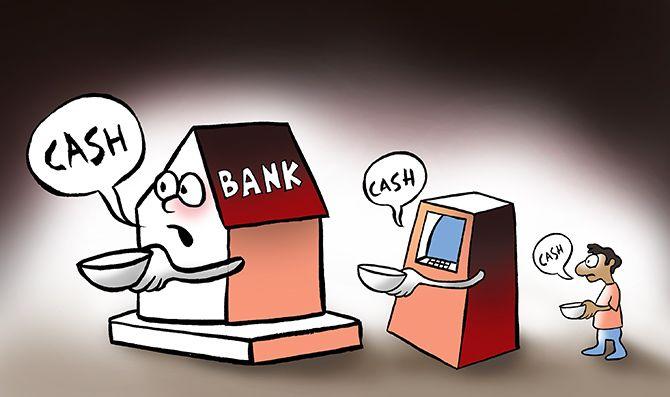The system envisaged under the FRDI Bill, if implemented properly, would help improve the efficiency of capital allocation without harming consumers, and without risking the stability of financial firms, says Ajay Shah.
Illustration: Uttam Ghosh/Rediff.com

Under Indian socialism, it was difficult to start a business. Many, but not all, of those entry barriers have declined. But capitalism without firm failure is socialism for the rich.
Exit frameworks have developed in India, from the Securitisation and Reconstruction of Financial Assets and Enforcement of Security Interest (Sarfaesi) (2002) to the Insolvency and Bankruptcy Code (IBC) (2016) and now the Financial Resolution and Deposit Insurance (FRDI) Bill.
This is slow, hard work, which is the critical institutional infrastructure of the market economy.
Under Indian socialism, entry was blocked into most areas of business.
Over the years, many of those restrictions have ended. It's generally easy to start a real sector firm, but we do not allow foreigners to start some kinds of firms.
In finance also, areas like mutual funds or securities trading are open. The most closed business in India is banking.
We went from socialism without entry to capitalism without exit.
To achieve a mature market economy, establishing exit frameworks are as important as removing entry barriers.
Removing entry barriers tends to be an easy stroke-of-the-pen reform.
But exit frameworks are part of second-generation reforms, where institutional capacity has to be built.
The first milestone was Sarfaesi, which established the simple idea that if I pledged an asset as collateral for a loan, then the lender would be able to take away the asset if I failed to make payments.
Work on financial resolution began with the RBI Advisory group on reforms of deposit insurance, chaired by Jagdish Capoor (1999).
Justice Srikrishna's Financial Sector Legislative Reforms Commission (FSLRC, 2013) proposed a split between non-financial firms vs. certain financial firms (e.g. banks and insurance companies) where strong promises are made to consumers.
It argued that a bankruptcy code was required for the former, but a specialised version of the bankruptcy code was needed for the latter, which is operated by a statutory body called the Resolution Corporation (RC).
This was endorsed by a Working Group of the RBI and the ministry of finance (2014). In 2014, M Damodaran led a task force on building the resolution corporation.
A committee with officers of the ministry of finance and all the regulators drafted the FRDI, drawing on the FSLRC draft law.
This was published for public comments in September last year. It was approved by the Cabinet in June this year, and was placed in Parliament in August. A Joint Parliamentary Committee with 30 Members of Parliament is examining the Bill.
As was argued by the FSLRC, certain financial firms cannot be smoothly resolved by the IBC; they require a specialised resolution regime.
For example, since bank creditors are mostly numerous depositors, the IBC process of negotiation by creditors does not work.
Depositors require quick resolution administered by a statutory authority. Similarly, the IBC processes would be too slow when dealing with systemically important financial firms, where delays induce a financial crisis.
The RC would be financed by levying fees on the covered financial firms, but it may get funding from the government as well.
The Bill covers banks for deposit insurance. For resolution, it covers banks, insurance companies, payment firms, financial market infrastructure, as well as systemically important financial firms.
The remaining financial firms are covered by the IBC.
The Bill establishes monitoring financial firms, their classification in accordance with their financial health, and an orderly resolution of a failing firm by the RC.
When the firm is healthy, it would remain under the purview of the regulator, and when it fails, it will go under the administration of the RC, which would resolve it.
When the firm is on the verge of failure, the RC will get certain powers to ensure smooth resolution.
Resolution can be done using a number of tools. The tool most employed is the merger of the firm with a healthy firm chosen through a competitive process.
It is also possible to sell some of the assets along with the equivalent amount of liabilities to a healthy financial firm, so that the consumers continue to be serviced by the purchasing firm, and the remaining assets may go into liquidation.
There is much interest in one of the tools: The bail-in.
In a distressed bank, the liabilities exceed the assets. Someone needs to absorb this loss. In the latest recapitalisation of public sector banks, the government has chosen to absorb it.
It will continue to have the option to do this even after the FRDI Bill is enacted.
One option is the bail-in: To make the equity holders and creditors absorb the losses, by writing down their claims.
Bail-in may appear draconian, but is sometimes necessary.
The Bill features adequate safeguards: Regulations made in advance will specify which classes of liabilities can be bailed in; certain liabilities such as insured deposits and secured credit are exempt from being bailed in; bail-in power must respect the hierarchy of claims; only those liabilities can be cancelled where the instrument creating it contains a provision stating that the parties agree to the liability being eligible for a bail-in; no creditor (including depositor) must be left in a worse position than they would have been in the event of its liquidation, and if this does not happen, they would be given compensation by the RC; the bail-in powers can only be used by the RC in consultation with the RBI; the RC is required to forward the bail-in instrument to the Central government together with a report with explanation about the reasons why bail-in was required, and a copy of this report is to be laid before Parliament.
In the past, we in India had not taken the issue of financial firm failure head on.
We have improvised from one bankruptcy to the next. The costs of not allowing creative destruction are enormous.
The system envisaged under the FRDI Bill, if implemented properly, would help improve the efficiency of capital allocation in the Indian financial system, without harming consumers, and without risking the stability of financial firms.
Ajay Shah is a professor at National Institute of Public Finance and Policy, New Delhi.











